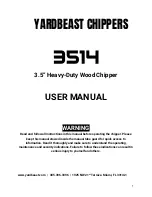
4
stream adversely affects performance. In order to
reduce maintenance costs and chiller downtime, a
water treatment program is highly recommended for
the condenser cooling water. Contact our Customer
Service Department for assistance in the proper
procedure for cleaning out any plugged condenser.
The nominal water-cooled condenser is design for
85°F condenser cooling water supply. Under normal
operation there will be about a 10°F rise through the
condenser resulting in 95°F exiting water. To ensure
proper water flow through the condenser, ensure the
condenser water pump provides at least 25 psi or
water at a flow rate of 3 gpm per ton of chiller
capacity.
Each condenser has a two-way condenser water-
regulating valve. The condenser water-regulating
valve controls the amount of water allowed to pass
through the condenser in order to maintain proper
refrigeration pressures in the circuit.
To prevent damage to the condenser and/or water-
regulating valve, the water pressure should not
exceed 150 psig.
Installation – Remote Condenser
Chillers designed for use with a remote air-cooled
condenser include a factory-selected remote
condenser. The remote air-cooled condenser
typically ships separately from a different location
than the chiller.
Location
The remote air-cooled condenser is for outdoor use.
Locate the remote condenser in an accessible area.
The vertical air discharge must be unobstructed.
Allow a minimum of 48 inches of clearance between
the sides and ends of the condenser and any walls or
obstructions. For installations with multiple
condensers, allow a minimum of 96 inches between
condensers placed side-by-side or 48 inches for
condensers placed end-to-end.
When locating the condenser it is important to
consider access to the components to allow for
proper maintenance and servicing of the unit. Avoid
locating piping or conduit over the unit to ensure
easy access with an overhead crane or lift to lift out
heavier components during replacement or service.
Proper ventilation is another important
consideration when locating the condenser. In
general, locate the unit in an area that will not rise
above 110°F.
Install the unit on a firm, level base no closer than its
width from walls or other condensers. Avoid
locations near exhaust fans, plumbing vents, flues, or
chimneys. Fasten the mounting legs at their base to
the steel or concrete of the supporting structure. For
units mounted on a roof structure, the steel support
base holding the condenser should be elevated
above the roof and attached to the building.
Avoid areas that can create a “micro-climate” such as
an alcove with east, north, and west walls that can be
significantly warmer than surrounding areas. The
condenser needs to have unrestricted airways so it
can easily move cool air in and heated air away.
Consider locating the condenser where fan noise
and vibration transmission into nearby workspaces is
unlikely.
The unit ships on its side with the legs removed to
reduce shipping dimensions and provide more
protection to the coil from possible damage caused
by impact loading over rough roads and transit
conditions.
Lifting
Use only qualified personnel using the proper
equipment when lifting and positioning the
condenser. Lifting brackets or holes are at the
corners for attaching lifting slings. Use spreader bars
when lifting to apply the lifting force vertically.
Under no circumstances use the coil headers or
return bends in the lifting or moving of the
condenser.
Mounting Legs
Assemble the corner legs to the bottom flanges on
the unit side panels and end panels using the
hardware provided and the matching mounting
hole-patterns. All corner legs are the same.









































